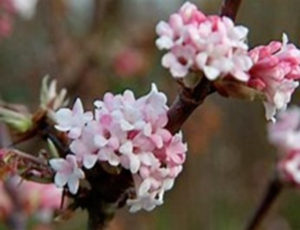Well, so much for gardening in February – if the ground wasn’t frozen, it was underwater!
All I managed to do was water my basil on the kitchen windowsill; top tip, don’t bother with sowing basil, buy a basil herb plant from a supermarket, split into three, re-pot and bingo instant basil that keeps on growing!
By the time you read this, the weather should have improved (if you can believe the weather forecast) and the first daffodils should be shining bright – a welcome sign that spring is here. This means that winter flowering shrubs can be pruned – mahonia benefits from a good hard prune every few years, some of the old stems can be taken out of your Viburnum bodnantense, and Cornus (dogwood) and Salix (willow) need to be taken back to 5cm from the ground or just above previous years cuts to encourage

new growth for good stem colour. Vibernum bodnantense is a beautifully scented winter flowing shrub with pink flowers (left).
Cornus midwinter fire is a particularly attractive variety (below). If you have some gaps to fill, now is a good time to plant bare rooted shrubs before they spring into life. Snowdrops can be lifted, divided and replanted once the foliage starts yellowing.
Herbaceous plants can also be lifted and divided if they have become too congested and consider weeding and staking around them too before the growth becomes too vigorous. In the vegetable garden, salad leaves can be planted in a cold frame or under cloches, seed potatoes should be put somewhere light and frost free (ie not too warm) to ‘chit’ or sprout before being planted out in April onwards.
divided if they have become too congested and consider weeding and staking around them too before the growth becomes too vigorous. In the vegetable garden, salad leaves can be planted in a cold frame or under cloches, seed potatoes should be put somewhere light and frost free (ie not too warm) to ‘chit’ or sprout before being planted out in April onwards.
Woody garden herbs such as lavender and sage can be pruned to within 2cm of the previous year’s growth. Blueberries can also be pruned by taking out up to a quarter of the oldest stems to promote new growth.
Article by: An amateur Gardener